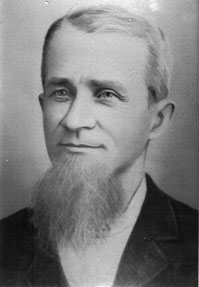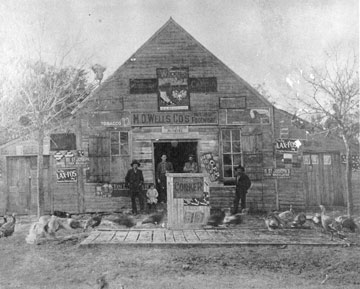Nechanitz – The ONLY one in the World!
 There’s no place like home! You’ve all heard that phrase before. Nechanitz was a great home to hundreds once upon a time. People from out of our county can’t pronounce it and wonder where on earth it is! Well, it is a mere 10 miles or so northwest of La Grange off SH 77, down FM 2145. Newspaper columnist Leon Hale has visited Nechanitz several times during his career and then reminisced about it in his own inimitable way. Another columnist, Frank X. Tolbert, wrote about his stop here in October 1967 in the Dallas Morning News.
There’s no place like home! You’ve all heard that phrase before. Nechanitz was a great home to hundreds once upon a time. People from out of our county can’t pronounce it and wonder where on earth it is! Well, it is a mere 10 miles or so northwest of La Grange off SH 77, down FM 2145. Newspaper columnist Leon Hale has visited Nechanitz several times during his career and then reminisced about it in his own inimitable way. Another columnist, Frank X. Tolbert, wrote about his stop here in October 1967 in the Dallas Morning News.
The community in the James G. Wilkinson League flourished when Wenzel Matejowsky purchased his property (February 1870) and established his store in an existing building, thought to have been built in the 1840s - 1850s. It was an ancient “beautiful relic” with square nails in the flooring and walls. It probably never saw a coat of paint, but that somehow seems appropriate. One antique (1885-1890) picture of the store shows multiple colorful signs tacked up all over the front like a big bulletin board, advertising necessities such as St. Joseph Liver Regulator, GFP (something for women), M. D. Wells Company’s Reliable Footwear, reminders to “Chew” Corker, LAX-FOS and various tobaccos. A wood floored scale and stand can be seen right in front of the store, and a dozen or more turkeys are strutting around.
The cotton gin was across the road, so perhaps this was somehow a part of that enterprise. In 1878, Wenzel purchased machinery to develop a cotton gin for the Nechanitz area. It originally used horses to furnish the power, but later was improved to be driven by a steam engine. The gin continued under guidance of C&P Matejowsky (Wenzel’s sons Charles and Paul) into 1926 or so. Later, Herman C. (Ham) Hannes ran the gin. Laws by then required a Ginner’s Permit, issued by a Commissioner of Markets & Warehouses of the State of Texas.
A post office was opened in 1874. Wenzel’s application states there were approximately 50 families to be served and the nearest active post office was in Ledbetter, about eight miles away. A diagram of the proposed site had to be submitted with his application, which he had drawn up by Fayette County District Surveyor Richard A. Doss. On this diagram, the location is identified as being on the “old stage road to Ledbetter” shown originating in La Grange. (These words serve to reinforce family legend that this place was once a stopover site for travelers who probably used the store building then.) This process also allowed the naming of the community. Nechanitz is the German spelling of Wenzel’s birthplace - Nechanice, Bohemia. Wenzel was Postmaster from 1874 until his death in December 1904. Then his son Charles was appointed Postmaster on March 3, 1905. Later, Charles’s son Joe E. Matejowsky took over this position on May 1, 1946. Being discontinued in 1954, the Nechanitz post office set a national record for longevity under one family’s operation.
 Mercantiles were the adhesive element for the surrounding countryside, being its center of activity and a favorite meeting place. Some local residents probably made a daily visit just for the comfort that human connection gave. And, of course, in hot weather, there was always a cool refreshment to be enjoyed. In cold weather, sitting around the wood stove was a pleasant way to spend time in conversation, discussing weather or world problems and playing dominoes.
Mercantiles were the adhesive element for the surrounding countryside, being its center of activity and a favorite meeting place. Some local residents probably made a daily visit just for the comfort that human connection gave. And, of course, in hot weather, there was always a cool refreshment to be enjoyed. In cold weather, sitting around the wood stove was a pleasant way to spend time in conversation, discussing weather or world problems and playing dominoes.
Prosperous traders had to be patient, pleasant and trusting. Wenzel Matejowsky was all of these. He had to have good handwriting and possess knowledge of bookkeeping. He had to know when to give credit and when to take legal action for nonpayment. In young adulthood, in Nechanice, Wenzel assisted his father Anton as a shop and inn keeper; in Czech, a “Kupecky Mladenec.” Here in Texas in late 1860s, Wenzel entered into a partnership with his brother-in-law, Reinhard Aschen, as proprietors of a general merchandise store in Waldeck.
All kinds of goods were offered that folks didn’t grow, raise or make for themselves. Canned goods, sacks of flour, rice and cornmeal, nails, yard goods, trims, needles and thread, shoes, shirts and pants, spices and barrels of crackers were stocked on ceiling high shelves and in glassed display cases. A large cheese wheel was always in sight. Ropes, leather goods and farming implements could also be purchased. And let’s not forget the patent medicines with their colorful names and packaging. Beer and whiskey were popular. Commercial candy enticed both children and adults.
Running accounts were kept for families and individuals, with payment made on accounts as crops or other goods were sold. Buying from individuals and drummers was practiced. Bartering was practiced in those days involving many varying goods such as syrup, homemade lye soap, eggs, bacon and more. Sometimes, customers were paid for their bartered goods with trade tokens instead of money, thereby insuring their return.
Wenzel Matejowsky’s handwritten recipes seen in a very early (1850s) journal are for both animals and humans. He had a keen knowledge of medicine, read extensively in his subscribed medical literature, and was known to treat many various illnesses in the community of Nechanitz. Wenzel’s grandchildren have related many stories of how he dispensed advice along with medicine from large “brown bottles” kept in a special room in his store.
Kindness was extended to all the families living in and around Nechanitz. Families of Meiners, Wolff, Schuster, Oeser, Stork, Pietsch, Weishuhn, Meinke, Rauch, Albers, and others still have descendants in the area.
In the last quarter of the 19th century, every landowner (as well as sharecropper) grew cotton, corn, maize, and had small orchards and sugarcane patches. Each home had a kitchen garden planted with vegetables for family use. This is what the eye saw for miles around. Now, cattle take top billing.
On a Sunday in January 1971, tragically, a raging fire consumed the Nechanitz store. It destroyed this special gathering place in an often mispronounced place in Fayette County. This was a sad day for many relatives, friends and visitors from all over Texas. Its 19th century atmosphere held fascination for both the young and old alike.
Photographs: Wenzel Matejowsky
1890s Nechanitz Store—L to R in the doorway: Charles Matejowsky & Paul Matejowsky

